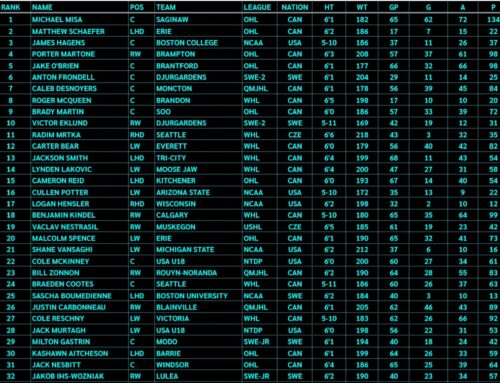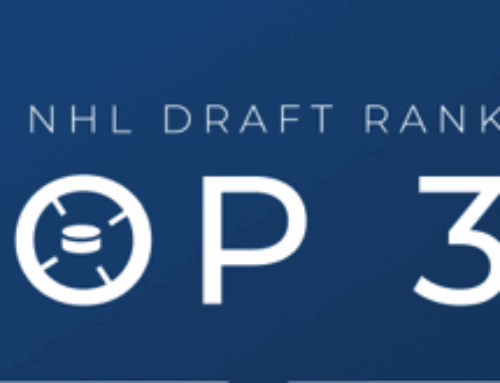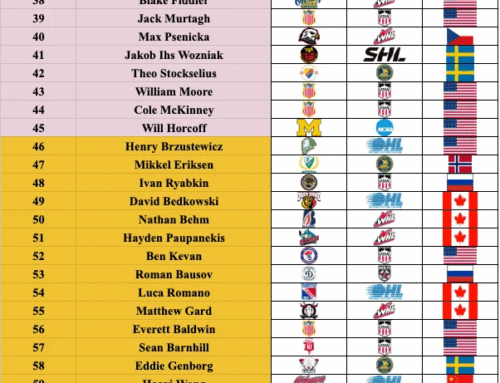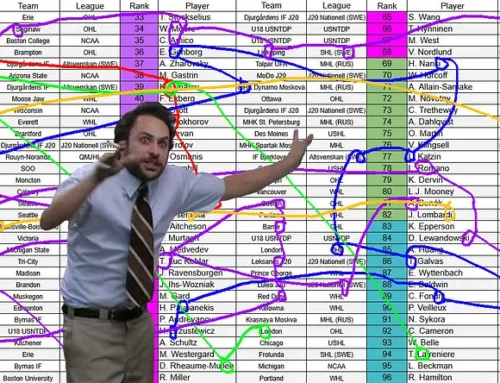2022 WJC Previews – Group A
Eetu Siltanen
2021-12-21
Whether you are a prospect enthusiast or a casual hockey fan, the annual World Junior Hockey Championship is one of the most anticipated events of the season. Not only does it bring a plethora of jaw-dropping moments, but it also gives hockey scouts and gungho fantasy goers a chance to bask in the glory of over, or in some cases, under hyping a specific youngster. Too often have we seen top-end talent disappoint, while otherwise “out of the blue” candidates boost their upcoming draft stock or fantasy value with a clutch WJC performance.
Here, the hard-working scouting team at Dobber Prospects breakdown each team’s roster, from line combinations to stand-out players. We kick off with Group A, which consists of Team Canada, Germany, Finland, Czech Republic, and Austria.
Team Canada
It wouldn’t be a World Juniors without some controversial decisions in the Team Canada selection process. Leaving the likes of Brandt Clarke and Matthew Savoie off the selection camp roster came as quite the shock for many in the hockey community, as both seemed like safe invites to camp at the very least. Especially Clarke, given he is not only a right-shot defenceman but arguably would have been the biggest offensive threat from the point on the roster.

Jacob’s Predicted Line Combinations
Although they were invited to camp, Luke Evangelista and Joshua Roy were left off the final roster, despite having tremendous seasons for their respective clubs. Without dwelling too much, it is evident this year, more than ever, that Hockey Canada selected their team with the intention of putting together the correct pieces, rather than an all-star team. Without further ado, let’s take a look at the players that have the privilege of wearing the leaf on their chest this upcoming tournament.
Despite some big names being left off the final roster, this team by no means lacks high-end talent. The projected first line of Cole Perfetti, Shane Wright, and Dylan Guenther is expected to generate tons of offense, as the likely first-overall pick in the upcoming draft (Wright) has two top-10 draft picks – who are both known for their offensive firepower – alongside him. Additionally, a second line of Kent Johnson, Mason McTavish, and Logan Stankoven is capable of being just as dangerous, with McTavish poised to have a massive tournament after his short, yet impressive stint in the NHL this year. If this top six can live up to expectations, Canada should not have an issue producing offense throughout the tournament.
The defense core is not crazy deep, but again, does not lack big names. Owen Power has had himself an insane start to his D+1 campaign with the University of Michigan and is expected to see heavy minutes in all situations. Kaiden Guhle, a rare returnee from last year, is also expected to provide some much-needed experience on the back end. He will be relied upon to play his trademark physical style in order to keep opponents away from the dangerous areas.
A huge positive to this Canadian roster – something that they have lacked going into a World Juniors for a long time – is a solidified number one goalie, which they have in Sebastian Cossa. The 6-foot-6 puck stopper from Hamilton was selected 15th overall in the 2021 NHL draft by the Detroit Red Wings. All eyes will be on him to provide security in the crease, especially since the defense has a few more question marks as in previous years.
In terms of potential surprises, the Canada roster is full of sneaky dangerous players that could be destined for a breakout, should they get put in the right scenarios. Obviously, the first name that comes to mind is 16-year-old, Connor Bedard. Although it is likely that he begins the tournament in the press box, this is a player that slots in perfectly to the top-six, if circumstances require him to. Bedard oozes talent and could end up putting up some incredible performances if he is given a good opportunity to do so.
Additionally, Ridly Greig centering a third line with Jake Neighbours and Justin Sourdif could be a dangerous line, with each player possessing offensive talent while being known for their relentless style of play. Even the fourth line of Will Cuylle, Mavrik Bourque, and Xavier Bourgault can punish opponents if they are sloppy, however, will mostly be responsible for their defensive and transition play. Elliot Desnoyers is the perfect role player for this Canadian team, as he is a versatile player that can be relied upon to contribute in basically any role in the bottom-nine. Lukas Cormier and Olen Zellweger will be asked to fill some pretty big roles on the back-end, so keep an eye out for their performance as the tournament goes on. And of course, Dylan Garand would be poised to take control of the crease if there are any mishaps with Cossa in net.
Expectations remain the same as always for Canada: Gold or bust. That being said, the keys to finishing on top of the podium are slightly different than in years past. Previously, the object was to outscore and out-star opponents, along with getting “good enough” defending and goaltending to hold them in tight games. This year, given the questions surrounding the defensive core and offensive depth of the skaters, there is a much greater emphasis on the play of Sebastian Cossa. The forwards are still expected to produce, but most of it is likely to come from the top-six, while the bottom half will be tasked with fending off the firepower of opposing teams. With this in mind, Canada’s path to gold will require them to be dominant in all three zones of the ice, instead of just the offensive zone.
Contributor: Jacob Barker, OHL Regional Scout.
Team Finland
Finland faces a tough challenge as always and although they have probably the best defender in the tournament (Topi Niemelä), they are still faced with a tough task, should they want to bring home some silverware. As always, Finland has an experienced team at the men’s level, having over a thousand Liiga games combined. They also have nine returnees from last year’s tournament (plus Blomqvist, who didn’t play a game). Sitting in group A, Canada will be their toughest opponent, while the Czechs always give a hard challenge as well. However, advancing to the quarterfinals should be relatively easy for the Finns.

Eetu’s Predicted Line Combinations
Losing top center Aatu Räty (NYI) because of Covid-protocols was a horrible loss for the Finns’ and could be quite detrimental to their medal hopes. If they face Russia in the quarterfinals, they have a solid chance to win, but against USA and Sweden, they would have to play a near-perfect game. But, as everyone knows, if there are upsets in the playoff rounds, it’s usually Finland who does them.
Finland’s defensive group suffered a minor loss, as Rami Määttä must stay home because of Covid-protocols. However, they still have a reliable group in the tournament. Returnees Eemil Viro (DET) and Topi Niemelä (TOR) should create one of the best defensive pairings in the whole tournament, while all the other defenders bring solid experience as full-time Liiga players. Viro is a mobile puck-moving defender, and Niemelä plays a good all-around game with great offensive impact (24 pts in 31 Liiga games). Aleksi Heimosalmi (CAR), who was selected as the best defender at last year’s U18 Worlds, and returnee Kasper Puutio (FLA) are both good puck-moving defenders and are the likely options to patrol the blue line on the team’s secondary powerplay unit. Ville Ottavainen (SEA) is also an interesting name, and he could see some time on the man-advantage as well. Furthermore, I could see him cycled in the defensive pairings. Finally, Petteri Nurmi and returnee Ruben Rafkin will probably serve more as a shutdown defensemen.
Finland’s winger group is going to be strong, but they already had a relatively weak center group before they lost Räty due to Covid-protocols. Now, it’s even more concerning. Returnee Roni Hirvonen (TOR) will likely be their first-line center and the second and the third centers are likely to be returnee Samuel Helenius (LAK) and Oliver Kapanen (MTL). The situation with centermen is quite complex and we could see a variety of players playing the middle in the tournament – for example, Brad Lambert (2022), Juuso Mäenpää, Sami Päivärinta, and even Joel Määttä.
Meanwhile, Finland’s situation with wingers is much healthier. Last year’s disappointment, Roby Järventie (OTT), should be one of the key forwards, alongside Ville Koivunen (CAR), top 2022-eligible Joakim Kemell, and returnees Kasper Simontaival (LAK) and Brad Lambert (2022). Koivunen should bring smart playmaking to the table, while Kemell, Järvintie, and Simontaival should be able to score some goals. It’s still unclear what Lambert’s role is going to be in the tournament, but I personally see him as a third-line winger and cycled in the top-six, if necessary.
There are multiple scenarios of how the wingers in the bottom half could line up and I believe that Head Coach Antti Pennanen is going to try multiple different combinations throughout the tournament. The team’s most interesting bottom-six wingers are Kalle Väisänen (NYR), Roni Karvinen and Olli Nikupeteri. I see Juuso Mäenpää also playing wing (probably the third-line), although listed as a center.
Joel Blomqvist (PIT) will likely be the starter for the Finns and could be the “dark horse” of the goalies in the tournament. His stat line in Liiga play is ridiculous this season (8 GP, 0.73 GAA, 0.964 SV%). Leevi Meriläinen (OTT) will likely be the backup and might get a couple of starts as well as he’s been solid in U20 NT games this season. Even though I see Blomqvist being the starter in the most important games, Meriläinen could give him a solid challenge for it. Juha Jatkola will likely be the third-string goalie.
Contributor: Eetu Siltanen, Head of Scouting/Director of European Scouting.
Team Germany
Lukas Reichel (CHI), Håkon Hänelt (WSH), Tim Stützle (OTT), JJ Peterka (BUF). All these names would’ve been available in terms of age, but they all are going to be absent from the tournament, for various reasons. Because of that, Germany will have a hard time in group A, after Covid destroyed their hopes of a more positive tournament last year. Games against Canada and Finland might get ugly. They’re going to have a big matchup against Austria, and it’s going to be a close game.

Eetu’s Predicted Line Combinations
Winning that should secure their advance to the quarterfinals, where they will have their work cut out for them against the division’s powerhouses. Worst-case scenario, they might have to play in relegation games. If there is a positive on their side, it is that Germany has combined for over 400 games of experience in the DEL league.
Germany’s defensive group isn’t going to be very strong, and it will rely a lot on the University of Vermont’s Luca Münzenberger (EDM), who will be one of the two NHL-affiliated prospects of team Germany. His game is based on good defensive skills and solid puck-moving. Other expected backbone defenders will be Maksymilian Szuber and Maximilian Glötzl. Szuber plays an offensive-minded game, while Glötzl has more of an all-around toolset. Fabrizio Pilu and Adrian Klein may surprise, but there aren’t big expectations on them. Unfortunately, Germany’s going to be an underdog in most of the games, so they will probably try to be as good defensively as they can be and just clear the zone always when possible.
Germany’s forward group doesn’t look very promising in terms of real impact players. However, they do have a group of solid players that have already played a chunk of DEL games throughout their career. Captain, Florian Elias, will have a lot of responsibility for this team. He’s a smart, two-way center with good skills. Forwards such as Justin Volek, Alexander Blank, and Danjo Leonhardt are players that could flash some decent offensive numbers. Jakub Borzecki, who is a physical player with solid finishing skills, and Bennet Rossmy have played on a line with Florian Elias this season’s during U20 national exhibition games, so I’m projecting that those three may find each other on a line. Other solid names in the forward group are Maciej Rutkowski and Joshua Samanski. Germany’s forwards are not the most skilled, and they will probably try to play a more shutdown game with tons of physicality to offset their struggle with productivity.
Goalies Florian Bugl and Nikita Quapp (CAR) are the backbones of this German team. They both are solid netminders and will probably each get a chance to play. From these two, it’s hard to say which one would be the starter at the beginning but if I had to say one, I’d go with Bugl. Niklas Luneman probably won’t even dress in any of the games if there are no complications and will serve as a third goalie the whole tournament.
Contributor: Eetu Siltanen, Head of Scouting/Director of European Scouting.
Team Czech Republic
The Czech Republic team is bringing over a medal caliber team this year. The depth of this forward and defensive group is incredible and while their goaltending could be better, it is certainly not bad at all. However, the Czech team has had similar luck to the Slovak team over the last (almost) decade, or so. Out of the last eight tournaments, they have advanced past the quarterfinals just once (2018). So, there is going to be a lot of pressure on this team to perform this year and they would love to significantly increase their standard of performance. Similar to team Slovakia, there are three more cuts coming at the venue to shape the final 25-player roster.

Samuel’s Predicted Line Combinations
Offensively, there is a lot of depth, as I said. Namely, it is very possible that a player like Jakub Brabenec (VGK), who is easily a point-per-game player in the QMJHL, might start in the bottom-six of the team (but not on my watch!). Very well-weighted roster construction allows for four very quality lines, with NHL-drafted talent spread throughout the team. Jakub Konečný (BUF), Michal Gut, Ivan Ivan, Martin Ryšavý (CBJ), and Josef Koláček have all had excellent seasons so far (this year) and could be important parts of this Czech team’s success.
Leading the way should be center Jan Myšák (MTL) – who was captain last year, and will likely be captain this year – who will generate offense from the first-line center spot. I expect a lot of skill-heavy plays from this group of forwards, tons of highlight reel offensive zone plays, crafty passes, and constant effectiveness. However, my main question will be: can they finish them? My answer would be yes, but that has been an issue in years past. Two more cuts will be made among this forward group, and my expectations are that Vojtěch Jiruš and Sebastian Malát would be those to fall short, but it’s all up to coaches.
Defensively, it is as strong of a group as any other. One of the best young defensemen on the planet, David Jiříček (2022, ranked #7), will be playing a heavy offensive role behind one of the top lines and should be relied upon on the powerplay. For me, this tournament will tell a lot about the player and the progress he has made over last year, as I have big question marks watching him on a week-to-week basis here in the Czech Republic. Stanislav Svozil (CBJ) will be relied upon heavily by the team in terms of defense and basically all situations. Michael Krutil (CHI) and Jiří Ticháček will likely (in my opinion) form a sturdy shut-down pair, although, their size may tell something different. Ticháček is more defensively oriented defenseman, so pairing Jiří with Krutil, who is also of similar mold, would be an incredible pair to use against top opposition, leaving lesser opposition to Jiříček’s offensive work. David Špaček, son of former NHL veteran Jaroslav, is having an incredible season in QMJHL and would be the primary option for the Czech team on the second powerplay unit.
Goaltending will likely be tandem-based, with Jakub Málek (NJD) and Jan Bednář (DET) sharing the load. Both are incredible goalies and quite different from the other, which allows the team to use them against different systems and get them in the best possible shape for top performance.
Contributor: Samuel Tirpak, Czech/Slovak/Central European Regional Scout.
Team Austria
I expect Austria to be above Germany among the group stage (and then get absolutely deconstructed by Sweden in the quarterfinals, but let’s not go there), as most of Germany’s big-name players decided not to attend, with exception of Leon Münzenberger (EDM) and Florian Elias. Austria has Marco Kasper (2022, ranked #27), Leon Wallner, Mathias Böhm, Vinzenz Rohrer (2022, NR), and one of the biggest stars from last year’s tournament, Sebastian Wraneschitz – who was saving Austria on a game to game basis last year.

Samuel’s Predicted Line Combinations
On defense, there are a lot of question marks. The only returnee from last year’s squad is Czech-born, right-shot defenseman, Lukáš Nečesaný, who is currently playing in AlpsHL for Red Bull Academy (along with almost half of this team). There is a lot of young blood in this team, and as things stand, they share the crown with Slovakia for the youngest team of the tournament at 18.11 years old. This is evident on defense, where only one singular player is 2002-born, Martin Urbanek. The rest of the roster is either 2003 or 2004 born players. One of the big names to watch for is David Reinbacher (2022, NR), who is a two-way right-shooting defenseman out of Switzerland. I expect him to get noticed by the hockey-viewing public and fellow scouts.
Forwards are this team’s biggest strength. They will be relying heavily on four main forwards to carry them in the group stage and mostly in the game versus Germany, which should be the deciding game for both teams. Marco Kasper (2022, ranked #27), Leon Wallner, Mathias Böhm, Seena Peeters, Vinzenz Rohrer (2022, NR) are the five players who are expected to carry the most burden on this team offensively and bring some results. Luca Auer (2022, NR), David Cernik (2022, NR), and Johaness Tschurnig (2022, NR) are other 2004-born forwards on this Austrian team to watch, despite being in more of a depth role this year.
Make no mistake about it, there are some very underrated names that highlight the best part of team Austria, the forward group. Peeters will be the one player they will rely upon for goalscoring, while Kasper should provide a ton of two-way value for the team and would most likely play in all situations – including powerplay and penalty kill. Wallner and Böhm had great chemistry together last year, so pairing them up with young Rohrer would be smart on their part. There are a bunch of players who can play anywhere in the lineup such as Fin Van Ee, Lukas Thaler, Oskar Maier, and so on, who are all very reliable but also very replaceable types of players. So, I would not be shocked if the whole forward group with exception of the second line and two-thirds of the first line are all in some kind of rotation.
In net, the clear number one goalie is last year’s hero, Wraneschitz and I don’t expect them to go with another goalie this year unless he gets hurt. I expect Lukas Moser or Leon Sommer to get the backup role behind Wraneschitz. Expectations are low for Austria, but I wouldn’t be surprised if they pull out a miracle and advance to the quarterfinals.
Contributor: Samuel Tirpak, Czech/Slovak/Central European Regional Scout.
Follow Eetu (@siltaneneetu), Jacob (@JacobMbarker12) and Samuel (@sammyt_51) on Twitter for all of your WJC needs!






